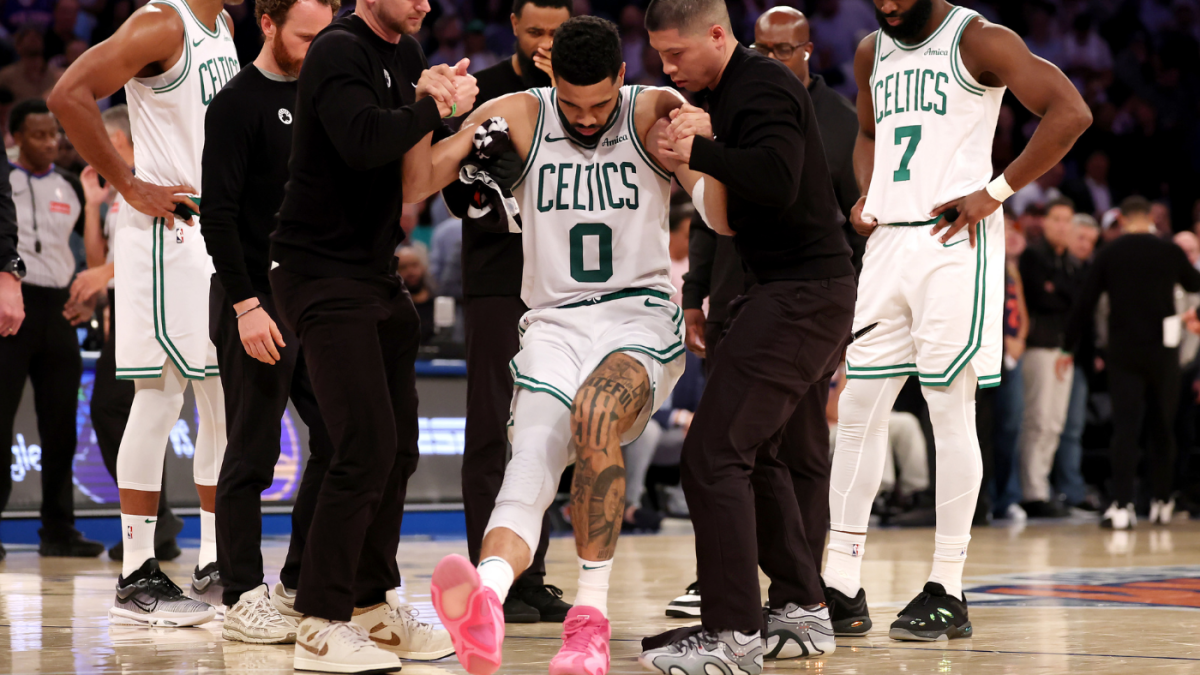The Impact of Jayson Tatum’s Injury on the Boston Celtics
A Devastating Blow to the Celtics’ Championship Hopes
Jayson Tatum’s injury during Game 4 of the Boston Celtics’ playoff series against the New York Knicks has sent shockwaves through the NBA community. The star forward suffered a torn Achilles tendon, a brutal blow that has not only ended his playoff run but also casts a dark shadow over the Celtics’ future. The injury occurred late in the fourth quarter, with Tatum collapsing to the floor after a non-contact incident, a nightmare scenario for any athlete. This type of injury is particularly devastating, as it often results in extended periods of recovery and rehabilitation.
The Immediate Aftermath
The immediate aftermath of Tatum’s injury was chaotic. The Celtics, who were already trailing in the series, were forced to play without their star player for the remainder of the game. Tatum was wheeled off the court with his head in his hands, a stark image that underscored the severity of the situation. The Celtics lost the game, and with it, their hopes of retaining the NBA crown were significantly diminished. The injury also raised questions about Tatum’s availability for the next season, as Achilles tears typically require extensive recovery time.
The Medical Details
Tatum underwent surgery to repair the torn Achilles tendon, a procedure that is standard for such injuries. The recovery process for an Achilles tear is lengthy and arduous, often taking anywhere from 9 to 12 months. This means Tatum is likely to miss the entire 2025-26 season, a devastating blow not just to the Celtics but to the NBA as a whole. The injury is particularly brutal because it occurred during a critical playoff game, leaving the Celtics without their star player at a pivotal moment.
The Broader Implications
The injury has far-reaching implications for the Celtics. Tatum’s absence will force the team to rethink their roster and strategy. The Celtics were already facing salary cap constraints, and Tatum’s injury adds another layer of complexity to their offseason plans. There are speculations that the team might undergo a significant roster breakup, with key players potentially being traded to manage the financial implications of Tatum’s extended absence. The team’s future is now shrouded in uncertainty, and fans are left wondering what the next season will look like without their star player.
Comparative Analysis
Tatum’s injury is reminiscent of Kevin Durant’s Achilles tear during the 2019 NBA Finals. Durant, who was 30 at the time, missed the entire next season and returned to play only 35 games the following season. His recovery journey serves as a grim reminder of the challenges that lie ahead for Tatum. The Celtics will need to navigate this period with resilience and strategic planning to ensure they can remain competitive in Tatum’s absence.
The Emotional Toll
The emotional toll of such an injury cannot be overstated. Tatum, who is in the prime of his career, will face a grueling rehabilitation process. The psychological impact of such a setback is significant, and the support of his teammates, coaches, and fans will be crucial during his recovery. The Celtics organization will also need to rally around Tatum, providing him with the resources and support he needs to make a successful comeback.
The Road to Recovery
Tatum’s road to recovery will be long and challenging. Achilles tendon injuries are notoriously difficult to rehabilitate, and the risk of re-injury is high. Tatum will need to undergo a rigorous physical therapy program, focusing on strengthening the affected area and gradually returning to full fitness. The Celtics’ medical staff will play a crucial role in guiding Tatum through this process, ensuring he returns to the court stronger and more resilient than ever.
The Impact on the Celtics’ Future
The injury has cast a long shadow over the Celtics’ future. The team will need to adapt to life without Tatum, at least for the next season. This could mean a significant overhaul of their roster, with new players brought in to fill the void left by Tatum’s absence. The Celtics will also need to focus on developing their younger players, ensuring they are ready to step up and contribute when the time comes. The team’s future is uncertain, but with the right strategies and support, they can navigate this challenging period and emerge stronger.
Conclusion: A New Chapter for the Celtics
Jayson Tatum’s injury marks a turning point for the Boston Celtics. The team will need to adapt to a new reality, one without their star player for the foreseeable future. The road ahead is fraught with challenges, but it also presents an opportunity for the Celtics to rebuild and redefine themselves. With resilience, strategic planning, and unwavering support for Tatum, the Celtics can navigate this difficult period and emerge stronger. The future is uncertain, but one thing is clear: the Celtics will need to rise to the challenge and prove they can compete without their star player.





